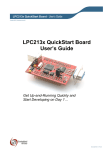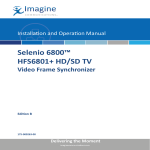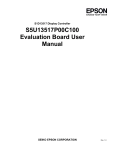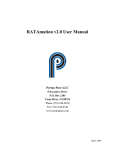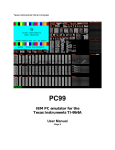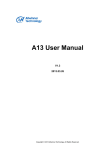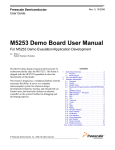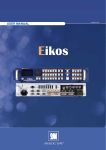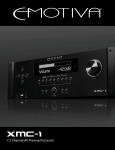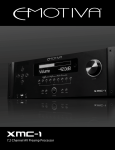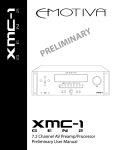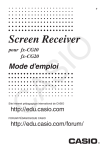Download AudioBridge HW User Manual
Transcript
SLIMbus Multilane Audio Bridge User Manual LnK 44, rue des Combattants B-4624 Romsée Belgium www.lnk-tools.com [email protected] SLIMbus Audio Bridge User Manual V3.02 - 31 July 2015 1 1. Presentation of the tool 4 2. Using the tool 6 2.1. Data Path 2.1.1. Input Section 2.1.2. Tone Generator Setup 2.1.3. Output Section 2.1.4. Loopback Mode 2.1.5. Manual Port Configuration 2.1.6. Port Status 2.2. Bus Status 2.3. Hardware Setup 2.3.1. SLIMbus Core Configuration 2.3.2. Audio Setup 2.3.3. External Clock Configuration 2.3.4. PLL Reference Clock Selection 2.3.5. Product Information and Diagnostic Values 2.4. Standby Switch 3. Bridge Connectivity 3.1. SLIMbus Connector 3.2. DSI Connector 3.3. Optical and Analogue Input Connector 3.4. Optical and Analogue Output Connector 3.5. SPDIF Input Connector 3.6. SPDIF Output Connector 3.7. External Clock Connector 3.8. USB 2.0 Connector 3.9. DC Supply Barrel Jack 3.10. DSI cable adapters 4. Clock Management 4.1. Framer Clock Generation 4.2. Audio Master Clock Generation 4.2.1. Input Clock Domain 1 (MCLKI1) 4.2.2. Input Clock Domain 3 (MCLK2) 4.2.3. Output Clock Domain 2 (MCLKO1) 4.2.4. Output Clock Domain 3 (MCLK2) 4.3. Common Frequencies 5. SLIMbus Operations 5.1. 5.2. 5.3. 5.4. Device Enumeration Channel Setup ASRC Configuration Audio Data Format SLIMbus Audio Bridge User Manual V3.02 - 31 July 2015 6 6 8 9 11 11 13 15 16 16 17 18 19 20 20 21 21 21 22 22 23 23 23 23 23 24 25 25 25 26 27 27 28 29 30 30 30 31 31 2 5.5. Using the Value Elements to configure the Bridge 6. Tone Generator Characteristics 6.1. 6.2. Pseudo Random Bit Sequence Sine Wave 7. Electrical Specifications SLIMbus Audio Bridge User Manual V3.02 - 31 July 2015 32 34 34 35 36 3 1. Presentation of the tool The SLIMbus Multilane Audio Bridge makes the link between SLIMbus Multilane and the analogue and digital legacy audio interfaces. The main purpose of the bridge is to allow easy tests of audio capabilities of a SLIMbus component with traditional audio analysers (Audio Precision, Rhode&Swartz ...). The bridge is also a fully featured and compliant SLIMbus component with one Interface device, a Framer device and a Generic device. It can be used to test other SLIMbus components (especially SLIMbus Manager or other audio components). Main features: - 12 bidirectional data ports - 2 SLIMbus data lines - 3 different and concurrent audio clock domains - SPDIF input and output - Optical input and output - DSI (I2S) stereo input and output - DSI (I2S) 8 channel input or output (with 4 data lines, no TDM) - Analogue stereo input and output - Tone generator (Sine, PRBS & DC value) - Data loop back function - Very flexible clock management SLIMbus Audio Bridge User Manual V3.02 - 31 July 2015 4 SLIMbus Enumeration Address Component address = 0 Device MID PID DI IV Enumeration Address Interface 0x01C1 0x0002 0x00 0x00 0x01C100020000 Framer 0x01C1 0x0002 0x01 0x00 0x01C100020100 Generic 0x01C1 0x0002 0x02 0x00 0x01C100020200 Component address = 1 Device MID PID DI IV Enumeration Address Interface 0x01C1 0x0002 0x00 0x01 0x01C100020001 Framer 0x01C1 0x0002 0x01 0x01 0x01C100020101 Generic 0x01C1 0x0002 0x02 0x01 0x01C100020201 Data Port Capabilities The 12 data ports support the Isochronous, Pushed and Pulled protocols. The Data Length is up to 32 bits. Port 0, 1, 8 and 9 are manually configurable to listen to already defined channels. SLIMbus Audio Bridge User Manual V3.02 - 31 July 2015 5 2. Using the tool The bridge can operate as a stand alone device. It has its own graphical user interface (4.3” colour display with touch screen) for the required parameter changes. The GUI is organised in three main pages: - Data Paths - Bus Status - Hardware Setup 2.1. Data Path This page shows the port status (and associated presence rate), the signal routing and various information like the Sample Rate converter status, the digital receiver status, the loop back configuration… The Data Ports are numbered from 0 to 11. There are two groups of ports. The first one has the first 8 ports (0 to 7). The second one has the last 4 ports (8 to 11). The first group uses the clock domain 1 (also referred as MCLKI1) for the Source ports and the clock domain 2 (also referred as MCLKO1) for the Sink ports. The second group has the same clock domain 3 (also referred as MCLK2) for both Source and Sink ports). The clock domains are identified by the background colour: - Clock domain 1 (MCLKI1) : light green - Clock domain 2 (MCLKO1): light orange - Clock domain 3 (MCLK2) : light blue 2.1.1. Input Section The input signals are shown on the left side of the display. On the clock domain 1, the SPDIF, Optical, DSI stereo and DSI 8 channels inputs are available as well as the internal tone generator. These input signals directly feed the port 0 to 3 inputs. Ports 4 to 7 can be directly fed by the tone generator or by the ports 0 to 3 input signals. On the clock domain 3, the SPDIF, Optical and analogue inputs are available. SLIMbus Audio Bridge User Manual V3.02 - 31 July 2015 6 Port Pair Stream P0 & P1 SDI1 P2 & P3 SDI2 P4 & P5 SDI3 P6 & P7 SDI4 P8 & P9 SDI5 P10 & P11 SDI6 Input interface Stereo SPDIF, Optical, DSI or Tone Generator DSI 8 Channels P0-P3 inputs or Tone Generator Stereo SPDIF, Optical & Analogue An asynchronous sample rate converter (ASRC) is available on each clock domain (1, 2 and 3) in case the signal sampling rate would not match exactly the SLIMbus channel Presence Rate. The ASRC is controlled via the HW Setup pages. When the ASRC is not in use, “DIRECT” is shown in the ASRC box. When it is activated, “ASRCxx” is shown, where xx is the sample size used by the ASRC (it can be 16, 20 or 24 bits). To Select an input signal, just press the corresponding button. The input feed of the Ports 4 to 7 is controlled by the round router. Press on it to toggle the data path. P4-7 inputs = P0-3 inputs P4-7 inputs = Tone Generator To activate the 8 channel DSI input, press the button “8Ch DSI In”. In this mode, all the other clock domain 1 inputs are deactivated. The clock domain 2 outputs are also disabled. The 4 input data streams are fed through the DSI connector. The corresponding word and bit clocks are outputs on the DSI connector (the DSI 8 Ch is always clock master). Press again the button “8Ch DSI In” to go back to nominal stereo operations. SLIMbus Audio Bridge User Manual V3.02 - 31 July 2015 7 2.1.2. Tone Generator Setup To configure the Tone Generator, press the Tone Setup button. A new page will appear with the tone generator parameters. The Tone Generator has two independent channels. The possible signal types are: - a constant (DC) value (set by the PC application). - a Pseudo Random Bit Sequence (PRBS) based on a 16 bit linear feedback shift register. - a selectable waveform (sine, square, triangle) with selectable frequency and amplitude. It is also possible to control the delay between the two channels and to sum the two channels on channel A. The desired output is selected by pressing the corresponding radio button. The frequency, amplitude and delay are changed by pressing on the text field. A keyboard will appear with a guidance tip. Type the desired value and finish the parameter edition by pressing the validate button. SLIMbus Audio Bridge User Manual V3.02 - 31 July 2015 8 When the Tone Generator parameter edition is finished, press the Exit button to go back to the Data Paths page. 2.1.3. Output Section The output interfaces are essentially stereo (two channels). The Data Ports are grouped by pair to output their signals to the selected output interface. As there are more port pairs than available output interfaces, it is necessary to select which port pairs will reach the outputs. Port Pair Stream Output interface P0 & P1 SDO1 Stereo SPDIF & DSI P2 & P3 SDO2 Stereo SPDIF & DSI P4 & P5 SDO3 Stereo SPDIF & DSI P6 & P7 SDO4 Stereo SPDIF & DSI P8 & P9 SDO5 Stereo Optical & Analogue P10 & P11 SDO6 Stereo Optical & Analogue DSI 8 Channels The connected stream is selected by pressing the button corresponding to that stream. SLIMbus Audio Bridge User Manual V3.02 - 31 July 2015 9 SDO1 on SPDIF & DSI SDO3 on SPDIF and DSI To activate the 8 channel DSI output, press the “8Ch DSI Out” button. When the 8 channel DSI output is activated, the stereo DSI is disabled. It is still possible to route any of the DSO1 to SDO4 streams to the SPDIF output. In order to operate properly, the 8 channel DSI output requires all the sink ports to use the same presence rate. If it is not the case, the display will show “8Ch PR=Mismatch”. The analogue output level is controllable. Press anywhere around the text “Attenuation” on the right bottom corner to call the numerical keyboard. Type any value for the attenuation. The value ranges from 0dB to 100 dB by step of 1 dB. SLIMbus Audio Bridge User Manual V3.02 - 31 July 2015 10 2.1.4. Loopback Mode The bridge can be placed in loopback mode to re-inject on SLIMbus the data it receives from SLIMbus. The loopback mode is controlled by a Value Element of the Generic device (see section 6.5 of this manual) or directly by the PC application. When the bridge is used in a stand-alone mode, it can only be activated through SLIMbus messages. The following table describes the stream connection. Port Pair Input Signal P0 & P1 SDO2 P2 & P3 SDO1 P4 & P5 SDO4 P6 & P7 SDO3 P8 & P9 SDO6 P10 & P11 SDO5 2.1.5. Manual Port Configuration The Data Ports P0, P1, P8 and P9 can be manually configured to transmit or receive audio streams. The main purpose of that function is to listen to data channel content without having been involved in the channel configuration through SLIMBus messages. The background behind these port boxes is purple, not grey. Push anywhere in the purple rectangle to call the port configuration panel. SLIMbus Audio Bridge User Manual V3.02 - 31 July 2015 11 By default, the ports are in the “Disconnected” state. There are two ways to manually configure a data port. a) Semi-automatic mode In this mode, the port will track all the messages related to the specified channels. It corresponds to the effect of a CONNECT_ message. The remaining of the port configuration is left to the SLIMbus protocol. To activate that mode, select a port configuration that is either Source or Sink then press the radio button Track Channel. Push on the text field to call the keyboard and enter a channel number. To finish the port configuration, press the Validate button. Once the desired ports are configured, press the Exit button to go back to the Data Paths page. b) Manual Setup In this mode, all the data channel parameters must be manually programmed. The full manual configuration corresponds to the complete channel configuration sequence: SLIMbus Audio Bridge User Manual V3.02 - 31 July 2015 12 - CONNECT_SINK or CONNECT_SOURCE BEGIN_RECONFIGURATION NEXT_DEFINE_CHANNEL NEXT_DEFINE_CONTENT NEXT_ACTIVATE_CHANNEL RECONFIGURE_NOW Enter all the parameters by pushing on the text field or pressing the buttons. The parameters take the values as shown in the SLIMbus specification. The keyboard tip guides the user when giving a value to a parameter. • • • • • • • SD is the Segment Distribution PR is the Presence Rate SL is the Segment Length DT is the Data Type TP is the Transport Protocol Line is the data line on which the channel appears SD1_ASSIGN is the mapping of the bridge data pin 1 to a given data line. Note: When used as a sink, the port protocol PUSHED correspond to both PUSHED and PULLED, the Presence bit being the same for both protocol. It is important to understand that the manual configuration mode is essentially designed to sniff the content of a data port without disturbing it. Therefore, the manually configured port will not act as an active port with the PULLED protocol. Once a manually configured channel is active, the port text is yellow, not white, to show the user that the port has a special behaviour. 2.1.6. Port Status When a port is not configured, it appears grey in the middle of the central bar. When a port is fully configured, its position and colour change depending on the function and clock domain to which it belongs. SLIMbus Audio Bridge User Manual V3.02 - 31 July 2015 13 The source ports 0 to 7 will appear on the left side, coloured in green. The sink ports 0 to 7 will appear in the right side, coloured in orange. The source ports 8 to 11 will appear on the left side, coloured in blue. The sink ports 8 to 11 will appear on the right side, coloured in blue. The source and sink ports are both blue because they belong to the same clock domain 3 (MCLK2). P0 is configured as a Sink Port P1 is configured as a Sink Port P2 is configured as a Source Port P3 is configured as a Source Port P4 is configured as a Sink Port P5 is configured as a Sink Port P8 is configured as a Source Port P9 is configured as a Source Port P10 is configured as a Sink Port P11 is configured as a Sink Port The presence rate is indicated once the ports are configured. Note: The source ports of each group must use the same Presence Rate because they all use the same audio master clock. The sink port pairs can have different Presence Rate as long as the stereo interfaces are used. The master clock is changed each time a new port pair is selected. When using the 8 channel DSI output mode, all the sink ports of the first group must use the same Presence Rate. It is possible to configure only one port of a pair or to have the two ports of a pair configured differently. In this case, the digital stereo stream connecting the SLIMbus port to the legacy interface will only carry one audio channel, the other one will carry 0s. SLIMbus Audio Bridge User Manual V3.02 - 31 July 2015 14 In this example, P6 will transport the channel B of the input stream SDI4. P7 will feed the channel A of the stream SDO4. P8 will feed the channel B of the stream SDO5 and P9 will transport the channel A of the input stream SDI5. 2.2. Bus Status This page displays the recorded bus configuration and the SLIMBus related registers of the bridge. The Framing Information is decoded and displayed. The Subframe Mode, Clock Gear and Root Frequency are explicitly shown. The programmed bus clock and the measured bus clock are shown for comparison. They must match. The framer status indicates if the bridge is the active framer or not. The physical layer information shows the programmed signaling level, the bus hold status and the data line mapping of the data pin 1 (SD1). This value reflects the content of the Value Element 0x400 of the Interface device. The five Geberic device Value Elements are also shown. These value elements are used to remote control the bridge (see section 6.5 of this document). SLIMbus Audio Bridge User Manual V3.02 - 31 July 2015 15 2.3. Hardware Setup This page has five sub-pages, each dedicated to a specific function of the bridge. - SLIMBus configuration - Audio setup - External clock configuration - Reference clock selection - Hardware information and diagnostic The sub-page navigation relies on the bottom button bar. 2.3.1. SLIMbus Core Configuration This panel allows the configuration of the various SLIMbus related parameters. The PHY signaling voltage can take any value from 0.9V to 3.2V (3.3V compatible) by step of 50 mV. Press the text field to call the display and type the desired value. The 50mV rounding is handled automatically. The Bus Hold can be enabled or disabled. If there is a Bus Hold active sowere on the SLIMbus, the bridge Bus Hold can be disabled. If not, there must be at least one active bus hold to guarantee error free operation and the bridge Bus Hold must be set. The Component Address (=Instance Value) can take the value 0 or 1. This allows the operation of two bridges on the same SLIMbus. The bridge Framer can be set as the Primary bus framer or not. By default, it should be disabled. The Boot Framing Information are fully programmable. The framer will use these values when it boot the bus. SLIMbus Audio Bridge User Manual V3.02 - 31 July 2015 16 Finaly, the SLIMbus core can be reset. This function shall be used when the boot mode or the boot framing information are changed and needed to be used immediately. Note that this is a full reset and that the bus will be completely reset also. 2.3.2. Audio Setup This panel groups all the audio interface parameters that can be programmed. Asynchronous Sample Rate Converters There are three sample rate converters in the bridge. Two are located at the inputs and one at the DSI output. They can be turned ON or OFF. The sample rate converter (ASRC) shall be used (turned ON) when the input sampling rate does not match exactly the SLIMBus channel presence rate. If the ASRC is OFF, samples will be missed or repeated, inducing THD. In the other hand, the use of an ASRC is not benign. It introduces a delay, pre and post ringing in the time domain and measurable ripple in the frequency domain. When a bit perfect transmission is required, the best practice is to clock the audio section of the bridge and the audio source with the same master clock. The DSI output ASRC can get two reference clocks: the internal MCLKO1 (clock domain 2) or the DSI MCLK input. This is to be used if the receiver connected to the bridge output cannot cope with the sample rate provided by the bridge. By default, this ASRC should be left OFF. Stereo DSI Interface configuration The signaling level of the DSI interface is programmable and can be 1.8V, 2.5V or 3.3V. Both stereo DSI input and output have programmable format and sample size. The format can be Left-Justified, Philips I2S or Right-Justified. When selecting Right-Justified, the sample size must be programmed for proper operation. The sample size can be 16, 20 or 24 bits. The interfaces can be clock master (active drive of the BCLK and LRCLK) or slave to the BCLK and LRCLK. SLIMbus Audio Bridge User Manual V3.02 - 31 July 2015 17 2.3.3. External Clock Configuration This panel groups all the controls related to the external clock management. The bridge has a single SMA connector to either input or output a clock signal. These controls program the behaviour of that connector. The main controls are the clock direction (input or output) and the clock signaling level (1.8V, 2.5V and 3.3V). Input Clock When configured as an input, the input impedance can be set to 50Ω or to high impedance (typically >1 MΩ). The SMA connector has a characteristic impedance of 50Ω and can be used to achieve long connection of high frequency signals without suffering reflections. If the clock source has a 50Ω output impedance, the signaling level at the connector input will be half of the output level of the source. Select the signaling voltage accordingly. For instance, a source generating a 3.3V clock signal will end up being 1.65V at the bridge SMA connector. Therefore, select 1.8V for optimal operation. If the clock source is only capable of sourcing 1.8V, it might be wise to shorten the link , to set the input impedance to 1M and to set the signaling voltage to 1.8V. The bridge constantly measures the frequency of the signal present on the SMA connector and displays it. Output Clock When configured as an output, the SMA provides a variety of clock signals. The output impedance is fixed at 50Ω. The output clock source is selectable. It can be a user defined frequency (derived from framer PLL ref clock), the framer reference clock (CG10), the audio MCLKI1, MCLKO1 or MCLK2. The selected frequency can be divided by an integer number to accommodate various use cases. The displayed frequency is measured and is provided to monitor the output. Not all integer factors are available to divide the clock. It all depends on the PLL settings. If the desired clock is obtain, all is fine. If the measured clock is either 0 or some other unexpected values, then the desired frequency is not reachable. SLIMbus Audio Bridge User Manual V3.02 - 31 July 2015 18 2.3.4. PLL Reference Clock Selection Both framer and audio PLLs can be fed by various clocks. This panel is used to select which clock will feed which PLL. Framer Reference Clocks The framer PLL can be fed by several clock sources: - Internal oscillator: a low jitter 12 MHz clock. - SPDIF input recovered master clock. Usually at 256 x Fs - Optical input recovered master clock. Usually at 256 x Fs - DSI master clock input. - External clock input (on SMA). Note that the reference clock does not need to match the desired framer clock. The bridge measures all the clocks and configures the PLL accordingly. If the selected clock appears to have the same frequency as the targeted clock, the PLL is bypassed. The four frequencies are measured and displayed to help the user to select the proper clock source. Framer Reference Clocks The Audio PLL can be fed by several clock sources: - SLIMbus clock - SPDIF input recovered master clock. Usually at 256 x Fs - Optical input recovered master clock. Usually at 256 x Fs - DSI master clock input. - External clock input (on SMA). When using the SLIMbus clock, the clock gear shall stay above 5 (CG6 to CG10). Below that frequency (<1.5 MHz), the Audio PLL will not lock properly anymore and the results will not be guaranteed. As for the framer PLL, if the selected clock appears to have the same frequency as the targeted clock, the PLL is bypassed. This property is useful to feed a master clock below 1.5 MHz into the bridge. SLIMbus Audio Bridge User Manual V3.02 - 31 July 2015 19 2.3.5. Product Information and Diagnostic Values The panel shows the product information: hardware revision, firmware revision, IP revision and the serial number. The diagnostic values show the measured main 3.3V supply voltage, the measured SLIMbus PHY voltage and consumed current, the Framer PLL (PLL2) monitoring output, the audio PLL (PLL1) monitoring output and the temperature measured by two internal sensor. On this panel, it is also possible to dim the LCD backlight. If the unit has to be tuned ON permanently, we strongly recommend to dim the backlight to the minimum. The typical life time of the backlight is 20000 hours, which corresponds to 2.3 years of continuous operation. By dimming the backlight to the minimum, the display life time can be extended to 5 years of continuous operation. 2.4. Standby Switch The standby switch is located besides the DC barrel jack, on the right side of the hardware. Toggle the switch (up or down) to activate the standby mode. The display backlight will be switched off, the interfaces will be disconnected and the auxiliary power supplies will be switched off. Sleep modes are activated wherever possible. When in standby mode, the yellow led located on top of the standby switch is ON to indicate that the bridge is powered but sleeping. The bridge will also wake up if it receives a command from its PC application. Using the standby mode allows the bridge to wake up almost instantaneously (much faster than with a power on). SLIMbus Audio Bridge User Manual V3.02 - 31 July 2015 20 3. Bridge Connectivity The bridge interfaces are located on the left and right side of the box. LEDs are often associated to the connectors to indicate a status. 3.1. SLIMbus Connector PIN SLIMbus signals DIR 1 CLOCK IN / OUT 3 DATA0 (Primary) IN / OUT 5 DATA1 (Secondary) IN / OUT 2, 4 & 6 GND Type: Standard 6 pin boxed header with pitch of 0.1”. The yellow led on the left side of the connector is ON when the connector pins are connected to the internal circuitry. It is possible to disable the SLIMbus connector while the bridge is powered by typing 0 in the PHY signalling level text field. When the bridge is in stand-by mode, the SLIMbus connector is also disabled. The SLIMbus IOs operates on a programmable level that ranges from 0.9V to 3.2V 3.2. DSI Connector PIN STEREO I2S IN & OUT DIR 8CH I2S OUT DIR 8CH I2S IN DIR 1 MCLKI OUT MCLKI OUT MCLKI OUT BCLKI IN / OUT SDO4 OUT SDI4 IN LRCLKI IN / OUT SDO3 OUT SDI3 IN 7 SDIN IN SDO2 OUT SDI2 IN 9 SDOUT OUT SDO1 OUT SDI1 IN BCLKO IN / OUT BCLKO OUT BCLKI OUT LRCLKO IN / OUT LRCLKO OUT LRCLKI OUT MCLKO IN MCLKO IN MCLKO IN 3 5 11 13 15 2..16 DSI IN DSI OUT GND Type: Standard 16 pin boxed header with pitch of 0.1”. SLIMbus Audio Bridge User Manual V3.02 - 31 July 2015 21 There are four LEDs around the DSI connector. - The bottom right green LED indicates that the DSI stereo input is used as input. - The bottom left red LED indicates that the 8 channel DSI output is active. - The top right bicolour LED indicates wether the DSI stereo output is clock master (red) or clock slave (green). - The top left bicolour LED indicates wether the DSI stereo input is clock master (red) or clock slave (green). All the DSI IOs operate on a programmable level that can be 1.8V, 2.5V or 3.3V. The source impedance of the DSI outputs is equal to 50Ω. The input impedance of the DSI inputs is greater than 1MΩ. When feeding a clock signal to the MCLKO pin, pay attention to the cable length for reliable operation. 3.3. Optical and Analogue Input Connector The Optical (TOSLINK) and analogue inputs are sharing the same 3.5mm jack connector. They cannot be used both at the same time. PIN Analogue signals TIP LEFT channel IN RIGHT channel IN RING SLEEVE DIR GND The bicolour LED on the left side of the input connector indicates that the Optical input is selected and if the receiver detects a valid IEC60958 audio digital stream. Optical input not selected: all LEDs OFF Optical input selected but no valid stream: yellow LED ON Optical input selected with a valid stream: green LED ON The green LED on the right side of the input connector indicates that the analogue input is selected. 3.4. Optical and Analogue Output Connector The Optical (TOSLINK) and analogue outputs are sharing the same 3.5mm jack connector. They cannot be used both at the same time. PIN Analogue signals DIR TIP LEFT channel OUT RIGHT channel OUT RING SLEEVE GND SLIMbus Audio Bridge User Manual V3.02 - 31 July 2015 22 3.5. SPDIF Input Connector The SPDIF connector is a standard RCA (cinch) connector. The input impedance is 75Ω. The bicolour LED on the right side of the input connector indicates that the SPDIF input is selected and if the receiver detects a valid IEC60958 audio digital stream. SPDIF input not selected: all LEDs OFF SPDIF input selected but no valid stream: yellow LED ON SPDIF input selected with a valid stream: green LED ON 3.6. SPDIF Output Connector The SPDIF connector is a standard RCA (cinch) connector. The output impedance is 75Ω. 3.7. External Clock Connector The external clock connector is a female SMA RF connector. Its characteristics impedance is 50Ω. The input impedance is switchable between 50Ω and 1MΩ. The bicolour LED at the bottom right side of the SMA connector indicates the direction of the signal. Green, it is set as an input. Red, it is set as an output. When the yellow LED at the top right of the SMA connector is ON, the 50Ω input impedance is active. 3.8. USB 2.0 Connector The USB 2 connector is used to remote control the bridge from a PC. The bridge is self powered and does not consume any power from the USB. Refer to the Audio Bridge software user manual for more detailed information. 3.9. DC Supply Barrel Jack This is the power supply connector of the bridge. The positive voltage is applied to the centre pin. Pin Signal DIR Centre pin VCC (9V to 12V) IN Outer ring GND SLIMbus Audio Bridge User Manual V3.02 - 31 July 2015 - + 23 3.10. DSI cable adapters Easy connection to Audio Precision APx analyser family with DSIO option is provided through a pair of custom cables. The cables are made of standard flat cables (16 ways) and standard plugs. The user can easily build its on length of cable but be aware of the propagation delays (about 1ns per15cm of cable). DSI 8 Channel Output Cable The cable has a pin header socket on one side (to connect to the bridge DSI) and a APx DSIO Receiver adapter on the other side. This cable shall only be used to transport the 8 channels from the bridge to the APx. To DSIO Receiver or Transmitter DSI Stereo Input and Output Cable The cable has a pin header socket on one side (to connect to the bridge DSI) and a pair of APx DSIO Receiver AND Transmitter adapters. This cable shall only be used when stereo connections are required from and to the APx analyser. The adapters have markings to help identifying the DSIO connector it shall connect to. To DSIO Transmitter To DSIO Receiver Refer to the Audio Precision DSIO module documentation for detailed information on the DSIO connector pinning. SLIMbus Audio Bridge User Manual V3.02 - 31 July 2015 24 4. Clock Management The bridge has a powerful and flexible clock management scheme. 4.1. Framer Clock Generation The Framer reference clock corresponds to the Root Frequency to be used on SLIMbus. If RF1(24.576MHz) has to be used, the framer clock generator will feed the SLIMbus Core with a frequency equal to 24.576 MHz. The framer clock can be generated by using five input clocks. The default one is the internal 12 MHz clock source. If the bridge framer must be frequency locked to another clock domain, any of the four other inputs can be used. The most accurate results will be obtained from the DSI master clock input (on pin 15) of from the external clock SMA connector. In some cases, the PLL can be automatically bypassed: • the PLL reference clock frequency is equal to the desired clock frequency • the desired clock frequency can be derived from the PLL reference clock by an integer divider This feature can be useful to avoid the jitter generated by the PLL or to be able to inject an “on purpose” jittered clock signal. 4.2. Audio Master Clock Generation The audio master clock corresponds to 256 x Fs when Fs<128 kHz and 128 x Fs when Fs >= 128 kHz. SLIMbus Audio Bridge User Manual V3.02 - 31 July 2015 25 The audio laster clocks can be generated by using five input clocks. Note that the three audio clock domains are all derived from a common clock reference (through a PLL or direct division). The default clock reference is the SLIMbus bus clock as if it was running at Clock Gear 6. This option is therefore only usable as long as the bus Clock Gear is greater or equal to 6. If the bus runs in Clock Gear 5 or less, the PLL cannot be used anymore with the SLIMBus as a reference. If the audio sample rates are not related to the SLIMbus clock (use of the Pushed or Pulled protocol, for instance), an external master clock shall be used. It can be any of the four other ones: • SPDIF input recovered master clock • Optical input recovered master clock • DSI master clock input on pin 15 of the DSI connector • External clock on the SMA connector It is also possible to use the sample rate converters but they will add their own contribution to the signal (delay, frequency response ripple and time domain ringing). The sample rate converters are provided for convenience but they shall not be used when the aim of the test is to characterise the Device Under Test audio performances. 4.2.1. Input Clock Domain 1 (MCLKI1) The following figure shows the block diagram of the clock domain 1 inputs. The SPDIF and Optical inputs have their own clock domain. The use of an ASRC appears to be necessary if the audio master clock MCLKI1 is not generated from the SPDIF or Optical clocks. The DSI input may also have its own clock domain when the interface is set as a clock slave. However, when the DSI input is set as clock master, the DSI input use the audio master clock MCLKI1 (clock domain 1) as reference. Note that the bridge tone generator is always using the audio master clock MCLKI1 as a reference. When using the DSI 8 Channel input mode, the interface is clock master and depends entirely on the MCLKI1 clock domain. SLIMbus Audio Bridge User Manual V3.02 - 31 July 2015 26 4.2.2. Input Clock Domain 3 (MCLK2) The following figure shows the block diagram of the clock domain 3 inputs. It is very similar to the clock domain 1 inputs with the exception that there is no DSI interface available in this group. Note that the analogue to digital converter (ADC) is always using the audio master clock MCLK2 as a reference. 4.2.3. Output Clock Domain 2 (MCLKO1) The following figure shows the block diagram of the clock domain 2 outputs. SLIMbus Audio Bridge User Manual V3.02 - 31 July 2015 27 The SPDIF output is always belonging to the internal clock domain 2. The DSI output can operate in different configuration. The following table lists the configurations that will not generate any audio stream disturbances. Clock Mode ASRC Clock domain Master OFF MCLKO1 Master ON DSI OUT MCLK Slave ON DSI OUT MCLK When using the DSI 8 Channel output mode, the interface is clock master and depends entirely on the MCLKO1 clock domain. 4.2.4. Output Clock Domain 3 (MCLK2) The following figure shows the block diagram of the clock domain 3 outputs. SLIMbus Audio Bridge User Manual V3.02 - 31 July 2015 28 Both outputs are slaved to the bridge clock domain 3. 4.3. Common Frequencies The following table lists the cardinal frequencies that are likely going to be used with the bridge. Note that the bridge makes a best estimate of the measured frequencies by comparing the measured value to the commonly used frequencies and use that estimated value to program the PLLs. Do not feed the bridge with an arbitrary frequency that does not relate in anyway to the frequencies listed in the table. The PLL generated frequencies might not be as accurate as necessary. Root Frequency PLL Generated Externally Fed RF=0 (“Not Indicated”) Not Possible Any frequency RF=1 (24,576 MHz) 24,576 MHz 24,576 MHz RF=2 (22,5792 MHz) 22.578998 MHz (Error of -202 Hz) 22,5792 MHz RF=3 (15,36 MHz) 15,36 MHz 15,36 MHz RF=4 (16,8 MHz) 16,8 MHz 16,8 MHz RF=5 (19,2 MHz) 19,2 MHz 19,2 MHz RF=6 (24 MHz) 24 MHz 24 MHz RF=7 (25 MHz) 25 MHz 25 MHz RF=8 (26 MHz) 26 MHz 26 MHz RF=9 (27 MHz) 27 MHz 27 MHz SLIMbus Audio Bridge User Manual V3.02 - 31 July 2015 29 5. SLIMbus Operations The bridge will operate accordingly to the SLIMbus specification. 5.1. Device Enumeration After the boot sequence, the bridge will send 3 REPORT_PRESENT messages. The Instance Value (IV) of the Enumeration Address depends on the value given to the Component address. Component address = 0 Device MID PID DI IV Enumeration Address Interface 0x01C1 0x0002 0x00 0x00 0x01C100020000 Framer 0x01C1 0x0002 0x01 0x00 0x01C100020100 Generic 0x01C1 0x0002 0x02 0x00 0x01C100020200 Component address = 1 Device MID PID DI IV Enumeration Address Interface 0x01C1 0x0002 0x00 0x01 0x01C100020001 Framer 0x01C1 0x0002 0x01 0x01 0x01C100020101 Generic 0x01C1 0x0002 0x02 0x01 0x01C100020201 5.2. Channel Setup When using the PLLs to generate the audio clocks, some care must be taken to ensure optimal data transmission and / or reception. The PLLs are configured once the associated Presence Rate is known. The SLIMbus Core communicates that information to the controller when a port is configured and when the associated channel structure and content have been defined by a valid reconfiguration sequence. Note that the channel does not need to be active yet to get the bridge to configure itself for the audio operation. Once the PLLs are configured and stable (it takes less than 3 ms), the channel can be activated and the data streaming will start without any latency or loss of data. The sequence of message will be as follow: *** CONNECT_SOURCE or CONNECT_SINK messages *** BEGIN_RECONFIGURATION NEXT_DEFINE_CHANNEL(...) NEXT_DEFINE_CONTENT(...) RECONFIGURE_NOW ... <--- At that moment, the PLLs get configured *** Delay for 3 ms *** ... SLIMbus Audio Bridge User Manual V3.02 - 31 July 2015 30 BEGIN_RECONFIGURATION NEXT_ACTIVATE_CHANNEL(...) RECONFIGURE_NOW ... <--- The data streaming is effectively starting If the channel activation message is in the channel setup sequence, there will be a delay of about 3 ms during which the data will either not be transmitted on the bus or not be read. When dealing with audio tests, it is definitively not an issue. When it is about verifying that every sample sent is well received, special care must be taken. Deactivating a channel does not reset the PLL settings. Therefore, the channel can be reactivated at any time and be immediately operational. Only a port reset (through a DISCONNECT_PORT or REMOVE_CHANNEL messages) will affect the PLL configuration. Note that these recommendations will not apply when an external clock source is used, as the audio clocks are required to be present and stable before the audio channel is activated. 5.3. ASRC Configuration The bridge uses the DL field (Data Length) to adequately set the output word length of the asynchronous sample rate converter. Dithering is applied on the LSB of the sample for optimal THD+N performances. The data lengths of interest are 16 bits (4 slots), 20 bits (5 slots) and 24 bits (6 slots). 32 bits data length is not an option when using the ASRCs. If the DL field is smaller than 4 slots, the ASRC output word length will be set by default to 16 bits. If the DL field is greater than 6 slots or set to “Not Indicated”, the output word length will be set by default to 24 bits. T h e d a t a l e n g t h i s s p e c i fi e d b y t h e D a t a L e n g t h fi e l d v a l u e i n t h e NEXT_DEFINE_CONTENT message. Make sure that the data Segment is large enough to fit the sample as defined by the DL field. Otherwise, the dithered bit will be lost and the sample truncation will lead to undesired distortions. If the ASRC is not activated, the DL field value will not have any effect on the bridge behaviour. 5.4. Audio Data Format The bridge supports 2 audio data formats: - DT=0 (“Not Indicated”) forces the bridge to use the 2’s complement data format. - DT=1 (“LPCM”) forces the bridge to use the sign&offset magnitude format defined by the SLIMbus specification. It will convert 2’s complement samples to LPCM and vice&versa. T h e d a t a f o r m a t i s s p e c i fi e d b y t h e D a t a Ty p e fi e l d v a l u e i n t h e NEXT_DEFINE_CONTENT message. SLIMbus Audio Bridge User Manual V3.02 - 31 July 2015 31 5.5. Using the Value Elements to configure the Bridge Most of the bridge parameters can be modified by using the Value Elements of the Generic device. To validate the bits set in the Value Element, the most significant bit (b7) of the Value Element must be set. Otherwise the Value Element content will not have any other effect than being displayed in the Bus Status page. The bit assignment is shown in the following tables. Bit Name V E 0 Description 0 INPUT1_SEL0 1 INPUT1_SEL1 2 INPUT1_SEL3 Select signal source of the ports 3 to 7 (0 = copy P1-P4, 1 = tone gen) 3 INPUT2_SEL0 4 INPUT2_SEL1 Select the signal source of the ports 8 to 11. 0 = SPDIF, 1 = Optical, 2 = Analogue. 5 INPUT1_ASRC_ENA Activate the Asynchronous Sample Rate Converter of the input 1 group 6 INPUT2_ASRC_ENA Activate the Asynchronous Sample Rate Converter of the input 2 group 7 VE0_VALIDATE Activate the functions of bit 0 to 6 when set to 1 Select the signal source of the ports 0 to 7. 0 = SPDIF, 1 = Optical, 2 = DSI, 3 = Tone Generator. VE0 of the Generic Device at address 0x800 Bit Name V E 1 Description 0 OUTPUT1_SEL0 1 OUTPUT1_SEL1 2 DSI_8CH_ENA Enable 8 CH mode on the DSI interface 3 DSI_8CH_MODE Set the DSI interface as input (0) or output (1) 4 OUTPUT2_SEL Select the port pair to be output on Optical and analogue outputs 5 DSI_OUT_ASRC_ENA Activate the Asynchronous Sample Rate Converter of the DSI output 6 DSI_OUT_ASRC_CLK Select the DSI output ASRC master clock (0= DSI, 1 = MCLKO1) 7 VE1_VALIDATE Activate the functions of bit 0 to 6 when set to 1 Select the port pair to be output on SPDIF and DSI outputs VE1 of the Generic Device at address 0x801 SLIMbus Audio Bridge User Manual V3.02 - 31 July 2015 32 Bit Name V E 2 Description 0 LOOPBACK_ENA Data loop back functionality. Enabled when set to 1 1 DAC_ATTN0 2 DAC_ATTN1 3 DAC_ATTN2 4 DAC_ATTN3 5 DAC_ATTN4 6 EXT_CLK_ZIN_SEL Set the input clock impedance (0 = 1M, 1 = 50R) 7 VE2_VALIDATE Activate the functions of bit 0 to 6 when set to 1 DAC output attenuation level in dB It ranges from 0 dB to 62 dB by step of 2 dB VE2 of the Generic Device at address 0x802 Bit Name V E 3 Description 0 DSI_LEVEL0 1 DSI_LEVEL1 Select the DSI signaling level 0 = 1V8, 1 = 2V5, 2=3V3 2 DSI_IN_FORMAT Set the Stereo DSI input format (0 = L-J, 1 = I2S) 3 DSI_IN_CLK_MODE Set the DSI IN Master/Slave clock mode (0 = Slave, 1 = Master) 4 DSI_OUT_FORMAT Set the Stereo DSI output format (0 = L-J, 1 = I2S) 5 DSI_OUT_CLK_MODE Set the DSI OUT Master/Slave clock mode (0 = Slave, 1 = Master) 6 EXT_CLK_DIR Set the external clock direction (0 = input, 1 = output) 7 VE3_VALIDATE Activate the functions of bit 0 to 6 when set to 1 VE3 of the Generic Device at address 0x803 Bit Name V E 4 0 EXT_CLK_LEVEL0 1 EXT_CLK_LEVEL1 2 CLK_OUT_SRC0 3 CLK_OUT_SRC1 4 AUDIO_PLL_REF0 5 AUDIO_PLL_REF1 6 AUDIO_PLL_REF2 7 VE4_VALIDATE Description Select the external clock signaling level 0 = 1V8, 1 = 2V5, 2=3V3 Select the clock to be output on the external clock connector 0 = Framer, 1 = MCLKI1, 2 = MCLKO1, 3 = MCLK2 Select the audio PLL clock reference 0 = SLIMbus, 1 = SPDIF IN, 2 = OPRICAL IN, 3 = DSI MCLK, 4 = SMA Activate the functions of bit 0 to 6 when set to 1 VE4 of the Generic Device at address 0x804 SLIMbus Audio Bridge User Manual V3.02 - 31 July 2015 33 6. Tone Generator Characteristics The internal tone generator offers basic signals for quick and simple tests. It has 2 independent channels. Not that the generator has not been designed to fulfil all the duties of a fully featured audio analyzer. The generator offers signals for all the sampling rates, from 8 kHz up to 384 kHz. There are 3 signals available: - A 32 bits constant (DC) value (per channel) - A Pseudo Random Bit Sequence (common to both channels) - A sine wave with selectable frequencies and amplitude (per channel). 6.1. Pseudo Random Bit Sequence The PRBS generator is based on a 16 bits linear feedback shift register (LFSR). polynomial is equal to X16+X14+X13+X11+1 (Fibonacci implementation). The The 32 bit sample is built with 2 copies of the LFSR: • Sample[31:16] = 214-LSRF • Sample[15:0] = 214-LSFR • The constant value 214 has been added to flatten the noise spectrum density. There is a small 1.5 dB rise from Fs/48 till Fs/2. Noise spectrum at a sampling rate of 48 kHz The LFSR cycle length is equal to 216-1 (65535). The LFSR is initialised with the value 0x0001. SLIMbus Audio Bridge User Manual V3.02 - 31 July 2015 34 6.2. Sine Wave The waveforms are built on a look-up table. The possible tone frequencies are given by the formula Ft = Fs x N / 3072. At Fs = 48 kHz, the frequency step is equal to 15.625 Hz. Dithering is applied to the samples at the appropriate location, depending on the Data Length information provided in the NEXT_DEFINE_CONTENT message that defined the data channel in use. The following plots show a 1 kHz sine wave @ 0 dBFs and Fs=48kHz. absolutely perfect, the signal purity is excellent (see the THD+N figures). Even if not 16 bits, THD+N = -95.5 dB 20 bits, THD+N = -120.2 dB 24 bits, THD+N = -143.8 dB 32 bits, THD+N = -152.9 dB SLIMbus Audio Bridge User Manual V3.02 - 31 July 2015 35 7. Electrical Specifications Power Supply Parameter Power supply voltage Min Typical 9 Operating power Standby power Max Unit 12 V 6 W 2.2 W DSI Interface Parameter Min DSI OUT signaling voltage (output) DSI OUT signaling voltage (input) Typical Max Unit 1.8 3.3 V 1.5 3,6 V 15 pF Input pin capacitive load Master clock frequency 2 24.576 MHz Word clock frequency 8 384(1) kHz 512 12.288 MHz Max Unit Bit clock frequency (1) 384 kHz when the 8 channel DSI mode is used. 192 kHz in stereo mode. SPDIF IN /OUT Interface Parameter Min Typical SPDIF IN signaling voltage 1 Vpp SPDIF IN impedance 75 Ohms SPDIF OUT signaling voltage 1 Vpp SPDIF OUT impedance 75 Ohms Sample Rate (input and output) 20 192 kHz Max Unit 96 kHz Max Unit OPTICAL IN /OUT Interface Parameter Sample Rate (input and output) Min Typical 20 External Clock (SMA) Parameter Min Typical Signaling voltage (input), Vclk =1.8V, 2.5V or 3.3V 1.5V VDD+0.3 V Signaling voltage (output) 1.8V 3.3 V 50 1M Ohms 25 MHz Input impedance Frequency SLIMbus Audio Bridge User Manual V3.02 - 31 July 2015 36 Analogue Output Parameter Min Full scale output level Typical Max 1 Output impedance 100 Bandwidth (-3dB) 3,8 Unit Vrms Ohms 0,546xFs or 20k Hz Frequency Response Flatness 0,05 dB THD+N (0dBFS, 20kHz BW) 0,002 % Dynamic Range 102 dB Analogue Input Parameter Min Input level (@ -0.5 dBFs) Typical Max 1 Input impedance Unit Vrms 47k Ohms 0,546xFs or 20k Hz Frequency Response Flatness 0,05 dB THD+N (full scale, 20kHz BW) 0,003 % Bandwidth (-3dB) 0.9 Dynamic Range 99 dB ASRC performances Parameter Min Typical THD+N (0dBFs, 24 bits resolution) Dynamic Range Input / Output Sampling Ratio SLIMbus Audio Bridge User Manual V3.02 - 31 July 2015 Max Unit -140 dB 142 1:16 dB 16:1 37 SLIMbus Electrical Performances Parameter Min Clock Gear range Typical 1 Unit 10 Operating frequency Signaling voltage Max 0.9 27 MHz 3.3 V Bus Hold impedance 33 kOhms Clock and Data output impedance 15 Ohms Clock and Data input capacitive load 20 pF SLIMbus Timing specifications With Internal Framer: TDV > 2 ns TDV < 7.2 ns With External Framer: ! TDV < 12 ns ! SLIMbus Audio Bridge User Manual V3.02 - 31 July 2015 38









































